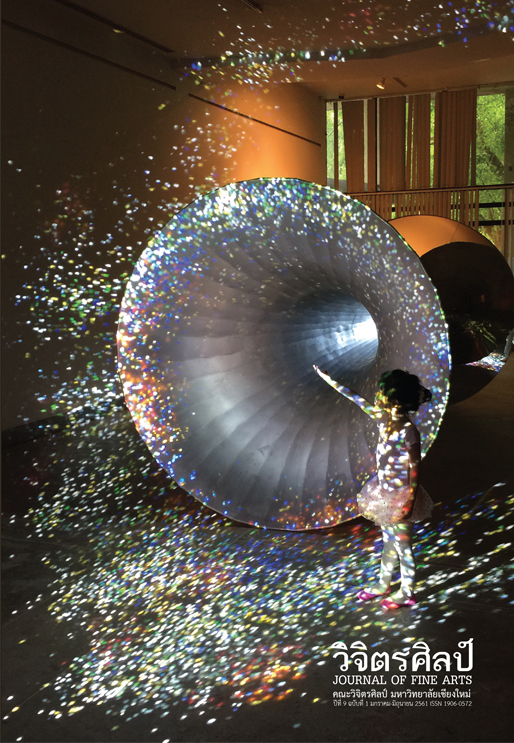การขยายประสบการณ์ภายในของตัวละครด้วยวิธีปฏิบัติภาวนาทางพระพุทธศาสนา กรณีศึกษา ตัวละคร นาก จาก Land & Skin: The Ballad of Nak Phra Khanong
Main Article Content
บทคัดย่อ
การวิจัยเรื่อง ศึกษาและพัฒนาสินค้าตกแต่งห้องทำงานจากอัตลักษณ์ไทยให้หน่วยงานภาครัฐเพื่อส่งเสริมแนวคิดการประยุกต์ใช้แท่งยาถมดำไร้สารพิษ เป็นการวิจัยในรูปแบบการวิจัยและพัฒนาผลิตภัณฑ์ (Research & Development) มีวัตถุประสงค์เพื่อศึกษาบริบทไทยจากแหล่งท่องเที่ยวรอบเกาะรัตนโกสินทร์ และนำเสนอแนวคิดการออกแบบผลิตภัณฑ์ที่ระลึกสำหรับการประชาสัมพันธ์แหล่งท่องเที่ยว ที่มีประโยชน์ ใช้สอย สร้างภาพลักษณ์ตกแต่งห้องทำงานหน่วยงานภาครัฐบาล ส่งเสริมแนวคิดการประยุกต์ใช้แท่งยาถมดำปลอดสารพิษ สิทธิบัตรของมหาวิทยาลัยศรีนครินทรวิโรฒ โดยมีกระบวนการวิจัยจากขั้นตอนการศึกษาบริบทไทยด้านสถาปัตยกรรมด้วยวิธีสังเกตการณ์ด้วยเครื่องมือทางทัศนศิลป์ การสเกตซ์ภาพร่วมกับการถ่ายภาพ เพื่อซึมซับคุณค่าเรื่องราวความสำคัญของบริเวณแหล่งท่องเที่ยวรอบเกาะรัตนโกสินทร์ จากนั้นคัดเลือกสิ่งที่ประทับใจที่ได้พบเห็นจากแหล่งท่องเที่ยว ต่อยอดและบูรณาการผลิตภัณฑ์ร่วมกับแนวคิดการประยุกต์ใช้แท่งยาถมดำปลอดสารพิษ ศึกษาบริบทเพิ่มเติมภาคเอกสารและสัมภาษณ์ผู้เชี่ยวชาญ วิเคราะห์ข้อมูลเพื่อสร้าง ข้อกำหนดการออกแบบ จากนั้นสังเคราะห์ออกแบบตราสัญลักษณ์และออกแบบผลิตภัณฑ์ที่ระลึกจากแหล่งท่องเที่ยวรอบเกาะรัตนโกสินทร์
ผลการวิจัยได้อัตลักษณ์และพหุลักษณ์ของแหล่งท่องเที่ยวในเชิงทัศนศิลป์ที่เป็นรูปธรรม และนามธรรมเรื่องราวคุณค่าเบื้องหลังความสวยงามของแหล่งท่องเที่ยวสำคัญบริเวณรอบเกาะรัตนโกสินทร์ ได้ข้อกำหนดแบรนด์รับรองผลิตภัณฑ์จากแผนที่เกาะรัตนโกสินทร์ชั้นในและชั้นนอกร่วมกับตัวอักษรด้วยรูปแบบเส้นพู่กันจีน ซึ่งแทนยุครัตนโกสินทร์ตอนต้นที่ได้รับรูปแบบศิลปกรรมผ่านการค้าขายกับประเทศจีน และแนวคิดผลิตภัณฑ์เพื่อการใช้สอยและตกแต่งโต๊ะทำงาน โดยบูรณาการร่วมกับแนวคิดการประยุกต์ใช้ยาถมดำไร้สารพิษ ที่เป็นสิทธิบัตรของมหาวิทยาลัยศรีนครินทรวิโรฒ ได้แก่
1. ที่เสียบปากกาจากแนวคิดแผนที่บริเวณเกาะรัตนโกสินทร์ 2. โคมไฟจากแนวคิดพระเจดีย์แห่งวัดพระศรีรัตนศาสดาราม (วัดพระแก้ว) ที่ได้สืบทอดต้นแบบจากวัดพระศรีสรรเพชรแห่งกรุงศรีอยุธยา และลวดลายประกอบจากลวดลายกระเบื้องเคลือบวัดอรุณราชวราราม (วัดแจ้ง) 3. กรอบรูปและที่วางนามบัตรจากแนวคิดอัตลักษณ์ของแหล่งท่องเที่ยววัดพระเชตุพนวิมลมังคลาราม (วัดโพธิ์) 4. ที่วางกระดาษโน๊ต ที่ทับกระดาษ และสามารถเสียบดินสอจากแนวคิดอัตลักษณ์ของแหล่งท่องเที่ยวเจดีย์บนภูเขาทองจำลองวัด สระเกศราชวรมหาวิหาร และสุดท้ายที่เสียบดินสอเอนกประสงค์จากแนวคิดอัตลักษณ์อนุสาวรีย์ประชาธิปไตยซึ่งมีรูปแบบทันสมัยได้รับอิทธิพลจากตะวันตก ซึ่งแทนสัญลักษณ์ของประชาชน จากนั้นพัฒนาขั้นสุดท้ายเป็นชุดผลิตภัณฑ์เครื่องใช้บนโต๊ะทำงานหน่วยงานภาครัฐ และเป็นของที่ระลึกเพื่อส่งเสริมภาพลักษณ์ประเทศไทย
Article Details
เอกสารอ้างอิง
วิจัยสร้างสรรค์ด้านศิลปะการแสดง.” วารสารศิลปกรรมศาสตร์
มหาวิทยาลัยขอนแก่น 8, 1 (มกราคม-มิถุนายน 2559): 107-130.
2. สำนักงานราชบัณฑิตยสภา. “ราชบัณฑิต จดหมายข่าวราชบัณฑิตยสถาน ปี
ที่ ๒ ฉบับที่ ๑๔, กุมภาพันธ์ ๒๕๓๓.” สืบค้นวันที่ 1 สิงหาคม 2560.
http://www.royin.go.th.
3. Barrette, E., and Bolt, B. Practice as research approaches to creative
arts enquiry. London: I.B. Tauris, 2010.
4. Brask, P., and Meyer-Dinkgräfe, D. Performing Consciousness. Newcastle upon Tyne: Cambridge Scholars Publishing, 2010.
5. Chamberlain, F., Middleton, D., and Pla, D. “Buddhist Mindfulness
and Psychophysical Performance.” Paper presented at the
International Symposium for Contemplative Studies, Boston,
2014. Retreived from http://eprints.hud.ac.uk/23013/1/
Chamberlain_ Middleton_Pla.pdf.
6. Demastes, W. Staging Consciousness. United States of America:
The University of Michigan Press, 2002.
7. Goodall, J. Stage presence. London: Routledge, 2008.
8. Kittikong, T. Noting the self: From embodying Buddhist Vipassana
meditation to meditation-based performance. Doctor of
Philosophy, Edith Cowan University, 2014. Retreived from
http://ro.ecu.edu.au/theses/1564.
9. Kittikong, T. “Choreographing the Site of Impermanence: Performing Body with Buddhist Philosophy and Meditation in Movement-based Performance.” Dance Movement and
Spiritualities Journal, 2, 1 (2015): 57-72.
10. Maneewattana, C. Reading Samuel Beckett in the Light of Buddhism: A case study in the tradaption of Waiting for Godot
into Thai buddhist context. Doctor of Philosophy, University
of Bristol, 2014. Retreived from http://ethos.bl.uk/OrderDetails.do?uin=uk.bl.ethos .654438
11. Meyer-Dinkgräfe, D. Theatre and Consciousness: Explanatory scope
and future potential. Bristol: Intellect, 2005.
12. Punpeng, G. Meditation in motion to mindfulness in performance:
a psychophysical approach to actor training for Thai
Undergraduate drama programs. Doctor of Philosophy,
University of Exeter, 2012. Retreived from https://ore.
exeter.ac.uk/repository/handle/10036/3652
13. Wisdom Library. Accessed August 5, 2017. https://www.wisdomlib.
org/defnition/sabhava.
14. Zarrilli, P. Psychophysical Acting: an intercultural approach after
Stanislavsky. London: Routledge, 2009.
15. Zarrilli, P., Daboo, J., and Loukes, R. Acting: Psychophysical Phenomena and Process: Intercultural and Interdisciplinary Perspectives. London: Palgrave Macmillan, 2013.


